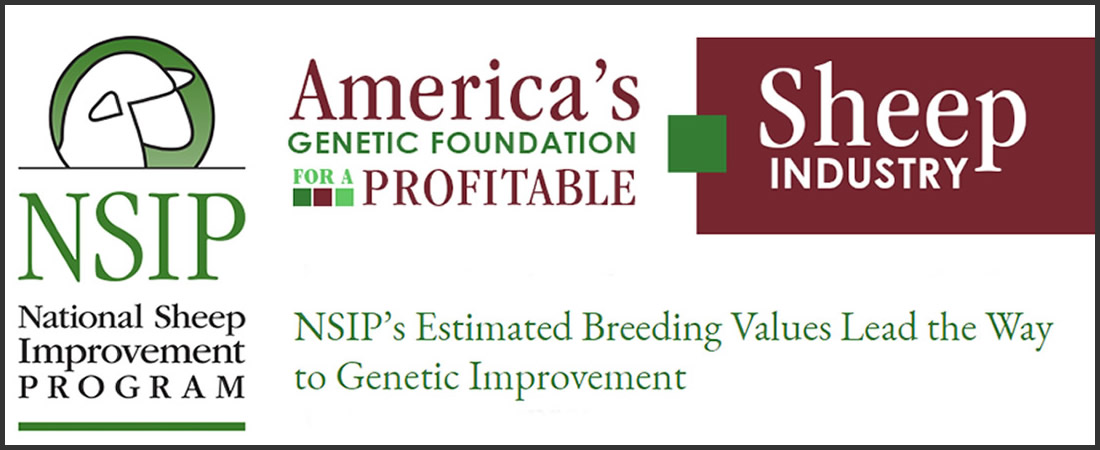NSIP – The National Sheep Improvement Program
What is NSIP?
It’s a program to help improve profits for American sheep farmers through detailed record keeping, genetic information, and advanced computing. Through NSIP, participants use genetic evaluations developed from their performance records together with visual appraisal to select superior breeding animals. Simply, the mission of NSIP is:
“To provide predictable, economically important genetic evaluation information to the American sheep industry by converting performance records into relevant decision-making tools.”
– NSIP.org
Learn More
NSIP Homepage
What is an Estimated Breeding Value or EBV?
Estimated Breeding Values, often referred to simply as EBVs, are measurements of certain economically-important heritable traits. Based on data collected on participating farms, EBVs are a measure of an individual animal’s performance, but also incorporate performance of related animals in that same flock, as well as related animals in other participating flocks. Scientifically based, EBVs have been tested in several breeds in a wide array of management systems across the U.S. sheep industry. The use of EBVs has been demonstrated to enhance economically-important decisions over visual appraisal alone.
“The backbone of America’s future commercial flock will be a ewe with parasite resistance, low maintenance costs, high fertility/prolificacy and good mothering ability. The National Sheep Improvement Program makes it possible to identify those animals.“
– Dr. David Notter
Professor and Sheep Geneticist
Virginia Polytechnic Institute
Learn More
Estimated Breeding Value
Understanding Sheep EBVs
Which Traits Are Tracked with EBVs?
In the Katahdin breed, most participating farms track and utilize the following traits:
- Birthweight (BWT)
- Maternal Weaning Weight (MWWT)
- Weaning Weight (WWT)
- Postweaning Weight (PWWT)
- Number of Lambs Born (NLB)
- Number of Lambs Weaned (NLW)
- USA Hair Index (aka Ewe Productivity Index)
Additionally, some Katahdin breeders track and utilize these additional traits:
- Postweaning Scrotal Circumference (PSC) (…formerly SC)
- Weaning Fecal Egg Count (WFEC) (…formerly WEC)
- Postweaning Fecal Egg Count (PFEC) (…formerly WEC)
- Postweaning Fat Depth (PFAT)
- Postweaning Loin Muscle Depth (PEMD)
Learn which traits would be important to your operation and purchase wisely. That’s doing your homework!
Learn More
EBV Descriptions
How Are EBVs Used?
Some producers of purebred breeding stock use EBVs to identify the superior animals in their flocks. With that information in hand, they can breed the best to the best and improve certain traits. This can rapidly accelerate genetic progress in their flock and ultimately in the breed. In addition to specific EBVs, certain traits have been combined (i.e., indexes) to facilitate selecting breeding stock that is better suited to particular environmental or management situations. Using EBVs, however, is not limited to producers of breeding stock, operators of commercial flocks know well what traits are important to their bottom line and can use EBVs to select superior replacement ewes or new sires with the genetics they need.
“By purchasing breeding stock with EBVs, commercial producers can focus on specific traits for genetic improvement and thus enhance their flock’s productivity and profitiblility.”
– NSIP.org
Additional Links
There’s a lot to learn when it comes to EBVs and we recognize that. Please contact us to see how you can use EBVs to select the right animals for your operation. Additionally, we provide the following links to help interested producers learn more about how they can be used. Commercial producers should be sure to review the “Ram Buyer’s Guide” which is designed to help prioritize animals using EBVs. The Katahdin NSIP Reports are updated twice annually with the leading Katahdins in the U.S. The Percentile Report is designed to help evaluate where an individual’s EBVs rank across all Katahdins. Finally, the NSIP promotional video puts it all together for a forage-based operation in the Upper Great Lakes Region.
Learn More
Using EBVs
Ram Buying Guide
What’s an EBV Worth?
Katahdin NSIP Reports
NSIP Participant Video

